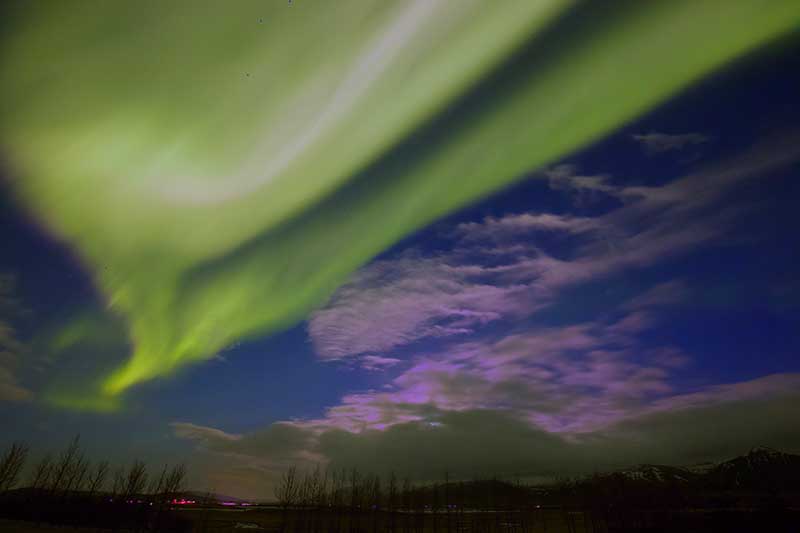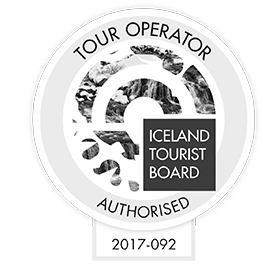- Vehicle Guide
- Passenger cars
- Estate
- Electric
- 4x4 SUVs
- Suzuki Jimny 4x4
- Dacia Duster 4x4
- Suzuki Vitara 4x4
- Suzuki Vitara auto 4x4
- Dacia Bigster 4x4
- Kia Sportage 4x4 Auto
- Kia Sportage PHEV 4x4 auto
- Mitsubishi Outlander PHEV 4x4 auto
- Toyota Rav4 4x4
- Toyota Rav4 4x4 auto
- Kia Sorento 4x4 auto
- Toyota Landcruiser 150 4x4 auto
- Toyota Landcruiser 250 4x4 auto
- Landrover Discovery 5 4x4 auto
- Landrover Defender 4x4 auto
- Prestige
- Minivans
- 4x4 Camper
- Motorhomes
- Driving in Iceland
- Our services
- Locations & Hours
- Travel Inspiration
- South Iceland: A complete guide
- Reynisfjara Beach in Iceland - Your Guide to a Safe Visit
- Best Times to Visit the Golden Circle in Iceland
- North Iceland: A Complete Guide for Drivers
- East Iceland A Complete Guide for Drivers
- West Iceland The Complete Driver’s Guide
- Your Ultimate Guide to Exploring Iceland’s Ring Road
- Driving the Diamond Circle in Iceland: Your Ultimate Guide
- Driving Iceland's Golden Circle: Your Ultimate Guide
- A 10-Day Itinerary in Iceland: Tips + Ideas
- The Perfect Itinerary for 7 Days in Iceland
- The Best Time to See the Northern Lights in Iceland with a Rental Car
- Renting a Camper in Iceland: The Complete Guide
- Getting to Iceland: A Comprehensive Guide on How to Reach the Land of Fire and Ice
- Nature Bath Locations in Iceland: A Complete Guide
- Iceland with Kids: A 5-Day Self-Drive Itinerary
- Winter Driving in Iceland: A Comprehensive Overview for Foreign Tourists
- The Total Solar Eclipse in Iceland – August 12, 2026
- Exploring Iceland's National Parks on a Self-Drive Adventure
- Exploring Iceland's Wonders: A Comprehensive Guide to Activities and Car Rentals
- Springtime in Iceland – Your Comprehensive Travel Guide
- Exploring Iceland's Most Popular Highland Routes
- The Pearls of Westfjords: The Ultimate Guide
- Exploring Iceland's Hidden Gems | Off-the-Beaten-Path Adventures
- Driving in Iceland in June: Tips for a Safe and Scenic Summer Road Trip
- Driving in Iceland in July: Tips, Routes & Rentals
- Driving in Iceland in August: Late-Summer Freedom on the Open Road
- Guide to Skaftafell Iceland Self-Drive A Journey Through Fire and Ice
- Eco-Friendly Road Trips in Iceland, Sustainable Travel Tips
- Photographer’s Paradise Top Scenic Drives in Iceland for Stunning Shots
- Iceland's Folklore and Legends A Road Trip Through Mythical Sites
- Iceland’s Midnight Sun and How to Make the Most of 24-Hour Daylight
- Exploring Iceland’s Viking Heritage: Top Historical Sites
- Chasing Waterfalls: A Road Trip to Iceland’s Most Spectacular Cascades
- Iceland's Volcanic Wonders: A Self-Drive Tour of Active and Dormant Volcanoes
- Tee Off in the Land of Fire and Ice: A Guide to Golfing in Iceland
- Birdwatching in Iceland: Puffins and Beyond
- Iceland’s Diverse Beaches: Beyond the Black Sands
- Icelandic Horses: The Unique Breed of the North
- Beyond the Ring Road: Iceland’s Hidden Scenic Drives
- Iceland’s Ice Caves: A Year-Round Adventure
- Wildlife Watching in Iceland: Where and When to Go
- Iceland’s Hidden Hot Springs: A Self-Drive Guide to Secret Soaks
- Navigating Iceland’s Weather: What to Expect Each Season
- Tröllaskagi Peninsula: Iceland’s Mountainous Marvel — A Scenic Road Trip with Höldur
- Mastering Iceland's Roundabouts: A Driver’s Guide
- Essential Tips for Renting a Car in Iceland
- Navigating Iceland’s One-Lane Bridges: Your Guide to Safe and Scenic Crossings
- Exploring Iceland’s Film Locations by Rental Car
- 5 Must-Visit Destinations Within Two Hours of Keflavík Airport
- Seasonal Car Rental Tips for Iceland’s Summer Festivals
- Understanding Iceland's F-Roads: How to Drive Safely Into the Highlands
- What Makes Iceland Unique: Top 15 Highlights for an Unforgettable Journey
- Driving and Hiking in Harmony: Explore Iceland's Natural Wonders with Höldur Car Rental
- Best Car to Rent in Iceland?
- Avoiding Common Car Rental Mistakes in Iceland
- Making Your Car Rental in Iceland Child-Friendly: Tips for Stress-Free Family Travel
- Exploring Akureyri, Iceland’s Northern Gem, with EasyJet and Europcar
- Renting a Manual or Automatic Car in Iceland
- Discover the Arctic Coast Way in Iceland with Höldur Car Rental
- How to Save on Fuel Costs During Your Iceland Road Trip
- Electric vs. 4x4 Rentals in Iceland: Which is Right for Your Trip?
- Top Scenic Detours Off Iceland's Ring Road
- Top Safety Tips for First-Time Drivers on Iceland’s Roads
- Cultural Pit Stops Along Iceland’s Ring Road
- Your Guide to Exploring Stuðlagil Canyon by Car: Iceland’s Basalt Beauty Awaits
- Day Trip Ideas From Reykjavik by Rental Car
- Visit Glymur Waterfall: The Ultimate Self-Drive Adventure from Reykjavík
- Discover the Volcanic Wonders of Lake Mývatn by Car
- Discovering the Magic of Snæfellsnes Peninsula by Car
- Your Self‑Drive Guide to Gullfoss Waterfall
- A Guide to Seljalandsfoss Waterfall in Iceland: Explore by Car
- Exploring Reykjanes Peninsula A Self Drive Guide
- Exploring Iceland Landmannalaugar by 4x4
- A Beginner's Guide to River Crossings in Iceland
- Best Car Rental Offers for Iceland’s Summer Adventures
- Your Self‑Drive Guide to Þingvellir National Park
- Your Ultimate Guide to Geysir, Iceland: All You Need to Know
- How to Pay for the Vaðlaheiðargöng Tunnel
- Your Guide to Visiting Jökulsárlón Glacier Lagoon
- The Diamond Beach in Iceland: A Sparkling Wonder Worth Visiting
- Parking fines in Iceland: how to pay and what to do if you receive one
- Where to find overnight parking in Reykjavík: a local’s guide for travellers
- How to park for free in Reykjavík: tips to save on your Iceland trip
- How to pay for parking in Reykjavík - A friendly guide for drivers in Iceland
- Game of Thrones Filming Locations in Iceland: A Self-Drive Guide
- How to Choose the Right Car Rental at Keflavík Airport
- Flying Within Iceland: Your Guide to Domestic Routes and Regional Airports
- Top 3 Must-See Attractions on Iceland's Golden Circle
- Hidden Gems Along the Golden Circle Route
- Your Essential Guide to Iceland: Currency, Culture, and Car Rental Tips
- How to Plan the Perfect Golden Circle Self-Drive Tour
- The Comprehensive Guide to Rental Car Sizes at Keflavik Airport
- Húsafell & Hallmundarhraun: Hidden Lava Field Adventures by Car
- Iceland Weather by Month: What to Expect and How to Drive Safely with Holdur Car Rental
- A Guide to Iceland’s Quirky Roadside Attractions
- Exploring Iceland’s Lava Tubes | Self-Drive Cave Adventures with Höldur Car Rental
- Coolcation in Iceland: Self-Drive Your Summer Escape to the North
- Driving Iceland’s Coastal Roads: A Guide to Lesser-Known Peninsulas
- Top Tips for Driving in Iceland Safely Year-Round
- The Best Rest Stops and Viewpoints Along Iceland's Ring Road
- Driving in Iceland in September: Embrace the Autumn Adventure
- Your Guide to Exploring Fjaðrárgljúfur – South Iceland’s Fairytale Canyon
- Explore Reykholt on a Self-Drive Tour in Iceland
- How to Choose the Right Insurance for Your Iceland Car Rental
- Hiking Múlagljúfur Canyon: Iceland’s Hidden Gem You Can’t Miss
- Understanding Iceland's Weather and How It Affects Driving Conditions
- Dyrhólaey: A Complete Self-Drive Guide to Iceland's Breathtaking South Coast
- Where to See Iceland’s Tectonic Plates Up Close
- Scenic Journey on Kjalvegur Road 35 Reykjavik to Akureyri
- Guide to Visiting Svartifoss with a Rental Car
- Kerið Crater Lake in Iceland: A Self-Drive Guide
- Your Complete Guide to Stokksnes, Iceland with a Rental Car
- Hengifoss Waterfall in Iceland: The Ultimate Self-Drive Guide
- Your Complete Guide to Visiting Skógafoss Waterfall with a Rental Car
- Into the Heart of Þórsmörk: Iceland’s Valley of Thunder
- Dynjandi Waterfall in Iceland: The Ultimate Self-Drive Guide
- Visiting Ásbyrgi Canyon in North Iceland by Car: A Complete Self-Drive Guide
- Driving in Iceland in October: Embrace the Autumn Transition
- Hraunfossar: Iceland’s Hidden Gem for Self-Drive Travellers
- Barnafoss Waterfall: Iceland’s Raging Cascade with a Legend
- Driving in Iceland in November: Your Complete Guide to a Spectacular Autumn Adventure
- Fishing in Iceland: All You Need to Know
- Öxarárfoss Waterfall in Iceland: A Self-Drive Guide with Höldur
- Life in Iceland: Essential Guide to Living in the Land of Fire and Ice
- People of Iceland - 12 Fun Facts About Icelanders
- Glaumbær Turf Houses: A Self-Drive Guide to Iceland’s Living History
- Húsavík: Whale Watching Capital of Iceland
- Svínafellsjökull Glacier: A Self-Drive Guide to Iceland’s Ice Giants
- Kirkjubæjarklaustur: A Historic South Coast Gem
- Vík í Mýrdal: South Iceland’s Coastal Treasure
- Namaskard: A Self-Drive Guide to Iceland’s Geothermal Wonderland
- Laufás Heritage Site: Where Iceland’s Past Lives On
- Navigating Iceland's Gravel Roads: Tips for a Safe and Smooth Drive
- Iceland's Best Stargazing Spots for Self-Drive Travellers
- Iceland's Best Picnic Spots: Scenic Stops for Self-Drive Adventures
- Top 5 Family-Friendly Hiking Trails Accessible by Rental Car
- 15 Tips for Travelling to Iceland
- How to Plan a Winter Photography Road Trip in Iceland
- Visiting Gljúfrabúi Waterfall — A Self-Drive Guide
- How to Spot Puffins in Iceland: A Self-Drive Adventure
- Your Essential Guide to Winter Tyres and Safe Driving in Iceland
- Iceland’s Most Active Volcanoes: A Self-Drive Guide
- Iceland’s Most Scenic Bridges and River Crossings: A Self-Drive Guide
- Iceland’s Most Instagrammable Spots for Self-Drive Travellers
- How Cold Is It in Iceland During Winter? A Self-Drive Guide
- Explore Dimmuborgir: A Self-Drive Guide to Iceland's Dark Castles
- The Ultimate Guide to Iceland’s Top 5 Waterfalls by Car
- Iceland’s Best Scenic Routes for Autumn Foliage: A Self-Drive Guide
- The Best Time to Visit Iceland for Self-Drive Travellers
- Self-Drive Adventures to Iceland’s Remote Lighthouses
- Selfoss Waterfall Self-Drive Guide: Explore Iceland Your Way
- All About the Icelandic Sheep
- Vestrahorn: A Self-Drive Guide to Iceland’s Stokksnes Peninsula
- Höfn, Iceland: The Lobster Town Self-Drive Guide
- Exploring Arnarstapi: A Self-Drive Guide
- A Guide to Iceland's Seasonal Foods for Your Road Trip
- Hverfjall Crater, Iceland: A Self-Drive Guide
- Self-Drive Guide to Visiting Askja
- A Self-Drive Guide to Visiting Kerlingarfjöll
- A Self-Drive Guide to Gunnuhver Geothermal Area
- Skriduklaustur, Iceland: A Self-Drive Guide to History & Culture
- Your Ultimate Guide to Visiting the Blue Lagoon in Iceland
- Borgarnes, Iceland: Top Things to Do & Self-Drive Guide
- A Guide to Glaciers in Iceland
- Car Rental Insurance in Iceland: What’s Usually Included, What’s Not & How to Choose
- Best Car Models for Iceland’s Terrain: Recommendations by Route
- Solo Traveller’s Guide to Self-Driving in Iceland
- Exploring Iceland’s Arctic Circle: What to See and Do
- How to Plan a Budget-Friendly Road Trip in Iceland
- The History of Iceland’s National Day: A Self-Drive Celebration
- Where to Spot Whales in Iceland: A Self-Drive Guide
- The Diamond Circle vs. The Golden Circle: Which Route is Right for You?
- Embracing a Greener Journey: Sustainability in Iceland
- Granni: A Self-Drive Guide to Iceland’s Neighboring Waterfall
- Háifoss: A Self-Drive Guide to Iceland’s Tallest Waterfall
- Iceland's Best Camping Spots for Road Trippers
- Gjáin: A Self-Drive Guide to Iceland’s Hidden Oasis
- Iceland's Hidden Waterfalls: Beyond the Tourist Trails
- Hjálparfoss: A Self-Drive Guide to Iceland’s Helping Falls
- Seasonal Self-Drive Itineraries in Iceland: What’s Open When?
- Kirkjufell: A Self-Drive Guide to Iceland’s Most Photographed Mountain
- Fjallabak Nature Reserve: A Self-Drive Guide to Iceland’s Rugged Highlands
- Hrafntinnusker: A Self-Drive and Hiking Guide to Iceland’s Obsidian Wilderness
- When to Visit Iceland: Northern Lights and Ice Caves vs. Hiking and Highland Adventures
- Visiting Laugarvatn Fontana Spa with a Rental Car: A Relaxing Icelandic Getaway
- Hvítserkur Rock: A Self-Drive Guide to Iceland’s Dragon of the North
- Skiing in Iceland: A Self-Drive Guide for Winter Adventurers
- Visiting the Mývatn Nature Baths by Car: A Self-Drive Guide
- Visiting Vök Baths in East Iceland: A Self-Drive Guide
- Visiting Skútustaðir Pseudo-Craters: A Self-Drive Guide
- Visiting Hljóðaklettar: A Self-Drive Guide on the Diamond Circle
- The Ultimate Guide to Exploring Reykjavik with a Rental Car
- Visiting Seljavallalaug: A Hidden Gem in South Iceland
- Guide to Sólheimajökull Glacier by Iceland Car Rental
- Eyjafjallajökull: Iceland’s Glacier Volcano
- Ísafjörður, Iceland: Your Ultimate Self-Drive Guide to the Westfjords
- What Continent is Iceland In? A Traveler's Guide
- Katla Volcano: A Guide to Iceland's Sleeping Giant
- The Magic of Icelandic Water: A Traveler's Guide
- A Guide to Exploring Akureyri by Rental Car
- A Self-Drive Guide to the Krafla Volcanic Region
- 12-Day Iceland Self-Drive: The Complete Itinerary
- Hekla Volcano: A Self-Drive Guide to Iceland's Gateway
- Visiting Deildartunguhver: A Self-Drive Guide to Europe’s Most Powerful Hot Spring
- Exploring Borgarfjörður: A Self-Drive Guide to West Iceland
- Exploring Stórurð: A Self-Drive and Hiking Guide to East Iceland
- Visiting the Forest Lagoon in North Iceland: A Self-Drive Guide
- Driving in Iceland in December: Embrace the Winter Wonderland
- Exploring Grábrók: A Self-Drive Guide to Iceland’s Volcanic Crater
- Exploring Látrabjarg: A Self-Drive Guide to Iceland’s Westernmost Point
- Iceland Car Hire Tips for UK Drivers: What You Need to Know
- 4-Day Iceland Winter Itinerary: The Best of the South
- Mount Mælifell: Iceland’s Emerald Volcano
- How Long to Drive Around Iceland? A Self-Drive Guide
- Driving in Iceland in January
- Exploring Djúpavík: A Self-Drive Guide to Iceland’s Remote Westfjords
- What to Wear in Iceland: Tips for Every Season
- Things to Do in Stykkishólmur: A Self-Drive Adventure Through Iceland’s Magical West
- The Secret Lagoon: Iceland’s Hidden Gem of Relaxation and Discovery
- The Silver Circle of Borgarfjörður: Your Ultimate Self-Drive Guide
- Snæfellsjökull: A Journey to Iceland’s Glacier of Legends
- Car Rental Iceland 4x4: Best 4WD Options for Your Trip
- What to See in Iceland: 20 Places You Don’t Want to Miss
- How to Prepare for an Iceland Road Trip
- Your Guide to Visiting Fagrifoss Waterfall by Car
- Exploring Stakkholtsgjá Canyon: A Self-Drive Adventure in Iceland
- Kolugljúfur Canyon: A Guide to Iceland's Hidden Gem
- Exploring Kvernufoss: A Hidden Gem in South Iceland
- Skógar Museum: A Journey Through Iceland's History
- 2 Days in Iceland: The Perfect Itinerary
- Exploring Berserkjahraun: A Self-Drive Guide to Iceland’s Lava Fields
- Driving in Iceland in February: Your Complete Guide
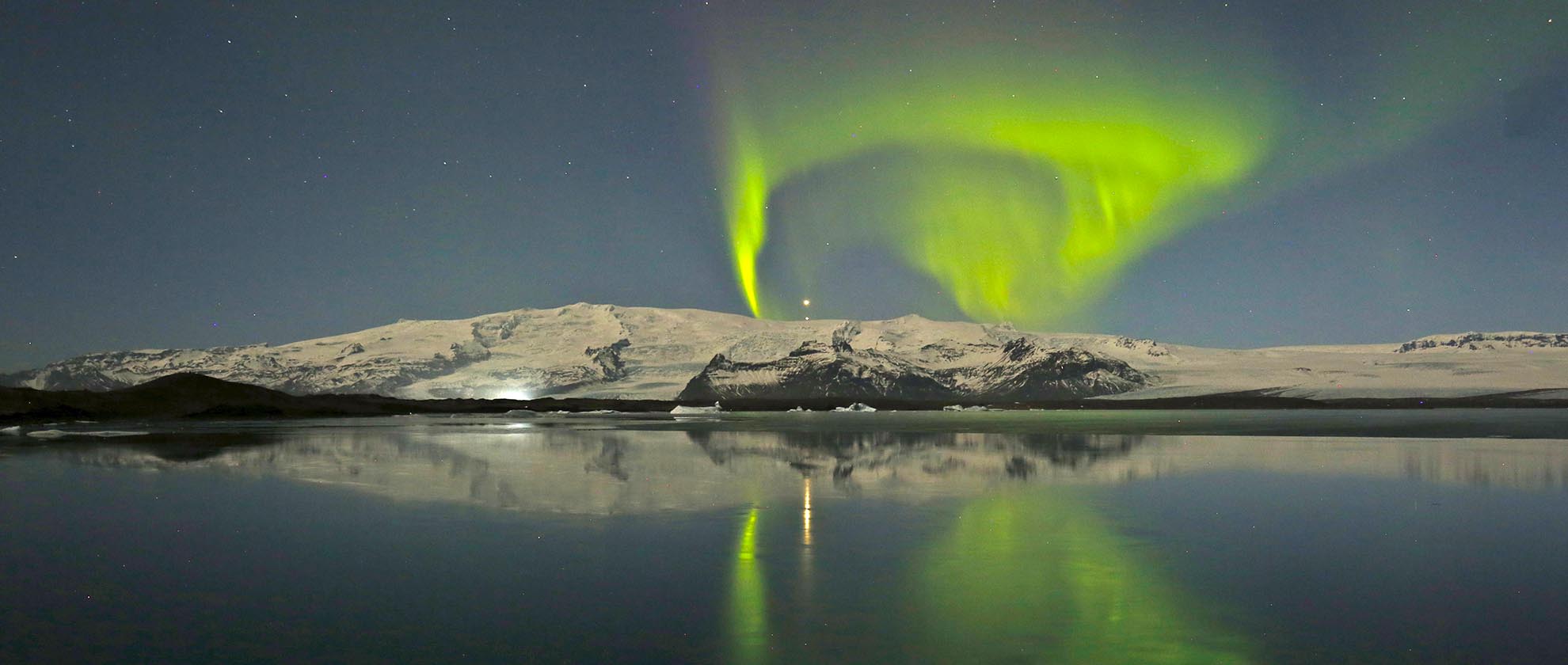
Practical Travel Tips
Your Guide to Seeing the Northern Lights in Iceland with a Rental Car.
08.02.2024
Iceland is one of the world’s best destinations to see the northern lights. Embarking on a self-drive northern lights tour in Iceland gives you the flexibility and freedom to witness this natural wonder at its most impressive.
While you can join a conventional tour group, having your own vehicle allows you to escape the crowds and find a secluded spot for a truly personal experience. This guide covers everything you need to know about planning your trip, from the best time to travel to the ideal conditions for an aurora sighting.
What are the Northern Lights?
The northern lights, or aurora borealis, are a vibrant, multicoloured light display seen in the dark skies of the northern hemisphere. They are widely considered one of the most incredible sights on Earth.
This celestial light show is caused by explosions on the sun's surface, known as solar storms. These events launch charged solar particles into space. Earth's magnetic field protects our planet by deflecting most of these particles, but some are channelled towards the north and south poles. The colourful curtains of light you see are the result of these solar particles colliding with molecules in our atmosphere.
Iceland's prime location in the far north and its vast, sparsely populated landscapes make it an exceptional place for aurora hunting. With minimal light pollution just a short drive from any town, you can see the display in all its glory. A reliable car hire for aurora hunting in Iceland is your ticket to this unforgettable show.
When to See the Northern Lights: The Ideal Conditions
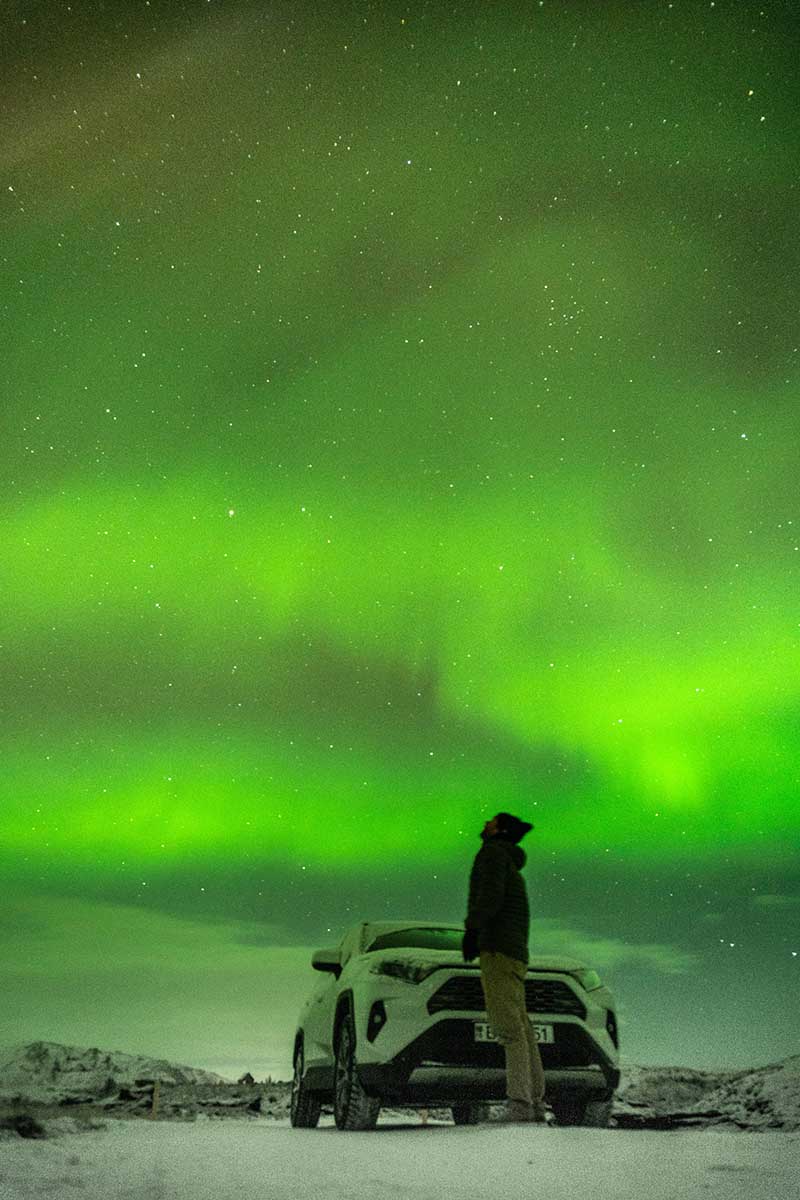
Seeing the northern lights is never guaranteed, as it depends on specific natural conditions. Understanding these factors will significantly increase your chances of a successful sighting.
You need three key elements to align for the best display:
- Strong Solar Activity: The aurora is dependent on solar storms. Scientists have identified that the sun goes through an 11-year cycle of activity, with periods of "solar maximum" offering more frequent and intense displays. The years 2023 to 2025 are one such peak period. You can monitor solar activity using resources like the Icelandic Met Office.
- Clear Skies: Cloud cover will obscure your view of the auroras. It is essential to check the weather forecast and find a location with clear skies. The Icelandic Met Office provides detailed cloud cover forecasts, helping you plan your drive.
- Darkness: Light pollution from cities and towns can dim the northern lights. To see the display at its most spectacular, it's best to drive into the countryside, away from artificial lights.
Having your own vehicle is a major advantage, as it allows you to move easily to find the perfect combination of these conditions.
What is the Best Time to See the Northern Lights?
The winter months are undoubtedly the best time for a northern lights trip, primarily due to the long, dark nights.
In December, Iceland experiences up to 20 hours of darkness per day, providing a large window for aurora viewing. However, the entire winter period, from September to April, offers ample darkness for a great chance to see them. While there is more daylight later in the season, you may find a higher probability of clear, cloud-free skies.
It is not possible to see the northern lights during the summer months (May to August). This is the season of the midnight sun, where daylight persists through the night, preventing the sky from becoming dark enough.
What time of day is best?
The northern lights can occur at any time, but they are only visible when it is dark. During the depths of winter, this could be from mid-afternoon until mid-morning. In September or April, you will need to wait until the evening for the sky to darken sufficiently.
Why a Rental Car is Essential for Your Aurora Adventure
To see the northern lights, you need to be able to chase the right conditions. Some parts of Iceland might be cloudy while others have clear skies. The freedom to move is crucial for a successful northern lights hunt.
That’s why the best car rental for northern lights in Iceland is one that gives you flexibility. A personal vehicle allows you to change your location based on real-time weather and aurora forecasts, maximising your chances of seeing the display. While organised tours are available, viewing the lights in a large group can detract from the serene beauty of the experience. With your own car, you can find a quiet spot to share the moment with your loved ones.
Ready to start your adventure? Book your northern lights car rental now and take control of your journey.
Best Locations in Iceland to View the Northern Lights by Car
Sometimes you can catch a glimpse of the aurora from anywhere, but more often, you need to seek out a specific spot with minimal light pollution and a clear view. Here are some of our favourite locations across the country that are easily accessible by car.
1. Snæfellsnes Peninsula
Located about a two-hour drive north of Reykjavík, the Snæfellsnes Peninsula is often called “Iceland in miniature.” It boasts a glacier, stunning coastlines, and the iconic Kirkjufell mountain. Surrounded by the ocean, the peninsula has very little light pollution, and when the aurora appears, it illuminates a breathtaking landscape. The entire area is reachable by car, making it perfect for a self-drive northern lights tour.
2. The Arctic Coast Way
The Arctic Coast Way is a 900 km (550 mi) route along Iceland's north coast, offering views of fishing villages, islands, and deep fjords. Any spot along this route can provide a fantastic opportunity to see the northern lights. For the best experience, position yourself away from the lights of Akureyri, the "Capital of the North." If you're planning to explore this region, arranging a car rental in Akureyri is an ideal starting point.
3. Jökulsárlón Glacier Lagoon
Jökulsárlón is one of Iceland's most famous natural wonders. This vast lake, filled with icebergs from the melting Vatnajökull glacier, is an incredible backdrop for the northern lights. With nothing but wilderness to the north, light pollution is practically non-existent. Witnessing the aurora borealis dance above the icy waters of the lagoon is a truly magical experience.
4. The Golden Circle
One of Iceland's most popular itineraries, the Golden Circle includes Gullfoss waterfall, the Geysir geothermal area, and Þingvellir National Park. All three are excellent destinations for aurora hunters and are easily accessible by car from Reykjavík. Þingvellir, less than an hour's drive from the capital, is a particularly good option for a shorter trip.
Why Choose Holdur for Your Northern Lights Car Rental?
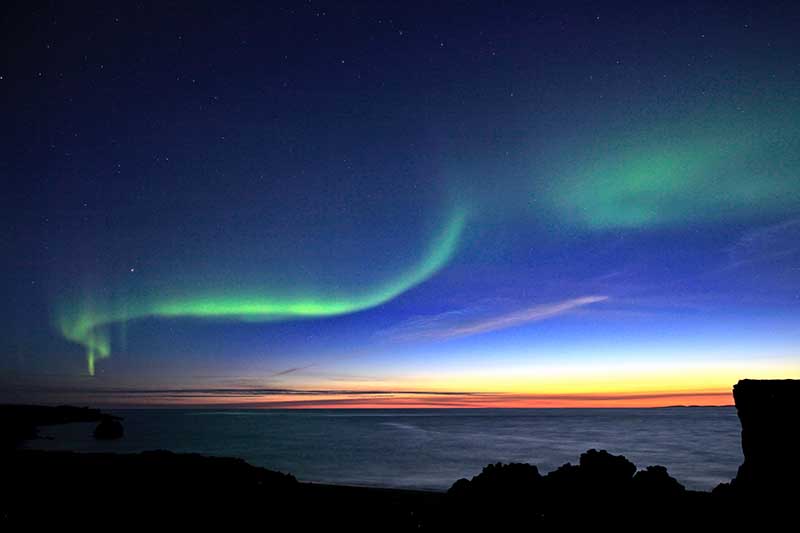
Choosing the right rental company is as important as choosing the right car. At Holdur, we provide more than just a vehicle; we provide peace of mind for your winter adventure.
- Winter-Ready Vehicles: All our winter rentals are equipped with high-quality studded winter tyres and snow scrapers at no extra cost, ensuring your safety on icy roads.
- Wide Range of Cars: Whether you need a compact car for a quick trip from the city or a robust 4x4 for exploring more remote areas, we have the perfect vehicle for your aurora adventure.
- Convenient Locations: Pick up your car as soon as you land with our car hire at Keflavik International Airport (KEF), or start your journey from the capital with our Reykjavik car rental service.
- 24/7 Support: Driving in winter can be unpredictable. Our dedicated team is available around the clock to assist you, ensuring you are never alone on the road.
Safety Tips for Winter Driving in Iceland
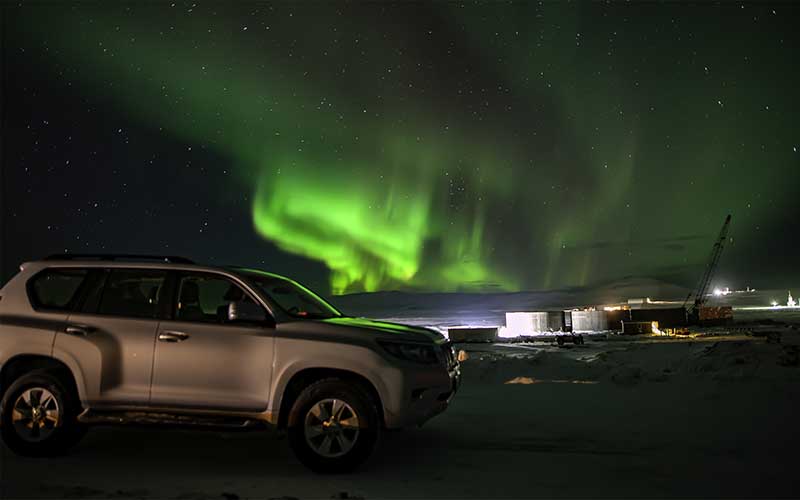
Northern lights season is winter, which means shorter days and challenging weather. Being prepared is key to a safe and enjoyable trip.
- Check Forecasts: Always check the weather forecast and road conditions at road.is before you set off.
- Pack Supplies: Carry extra layers, warm clothes, snacks, and water in your vehicle.
- Know Emergency Numbers: The emergency number in Iceland is 112. Our contact details are on the dashboard sticker and in our free travel app.
- Plan Your Route: Be aware that highland roads (F-roads) are closed in winter. Stick to main roads unless you have a suitable 4x4 and have confirmed the route is open.
Frequently Asked Questions (FAQs)
What type of car is best for northern lights in Iceland?
For most aurora trips on main roads, a 2WD car with winter tyres is sufficient. If you plan to venture into more remote areas or anticipate heavy snow, a 4x4 is recommended for superior handling and safety. All Holdur winter rentals come with studded tyres.
Can I see the northern lights in Iceland without a tour?
Yes. A self-drive northern lights tour is often the best way to see the aurora. It gives you the freedom to chase clear skies and find private viewing spots away from crowds, adapting your plans to the latest forecasts.
What is the best month to see the northern lights in Iceland?
December and January offer the longest, darkest nights. However, any time between September and April provides a good opportunity, and the shoulder months can sometimes offer clearer weather.
How can I maximise my chance of seeing the northern lights?
The best strategy is to stay for several nights, use the Icelandic Met Office forecast to find clear skies, and drive away from city lights. A rental car is essential for this flexible approach.
Your Northern Lights Adventure Awaits
Winter in Iceland offers a unique opportunity to witness the aurora borealis. With the freedom and flexibility of a rental car, you can create your own unforgettable journey chasing this spectacular light show.
At Holdur Car Rental, we provide reliable, winter-ready vehicles to suit your needs. We are the largest car rental operator in Iceland, ready to equip you for the adventure of a lifetime.
Find the perfect car for your aurora adventure and book your vehicle today.

